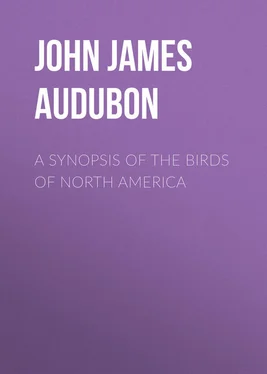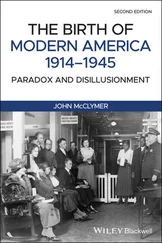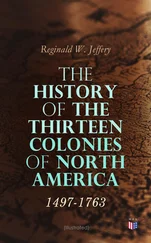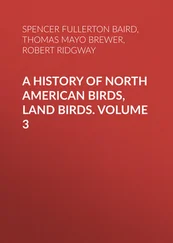John Audubon - A Synopsis of the Birds of North America
Здесь есть возможность читать онлайн «John Audubon - A Synopsis of the Birds of North America» — ознакомительный отрывок электронной книги совершенно бесплатно, а после прочтения отрывка купить полную версию. В некоторых случаях можно слушать аудио, скачать через торрент в формате fb2 и присутствует краткое содержание. Жанр: foreign_antique, foreign_prose, на английском языке. Описание произведения, (предисловие) а так же отзывы посетителей доступны на портале библиотеки ЛибКат.
- Название:A Synopsis of the Birds of North America
- Автор:
- Жанр:
- Год:неизвестен
- ISBN:нет данных
- Рейтинг книги:5 / 5. Голосов: 1
-
Избранное:Добавить в избранное
- Отзывы:
-
Ваша оценка:
- 100
- 1
- 2
- 3
- 4
- 5
A Synopsis of the Birds of North America: краткое содержание, описание и аннотация
Предлагаем к чтению аннотацию, описание, краткое содержание или предисловие (зависит от того, что написал сам автор книги «A Synopsis of the Birds of North America»). Если вы не нашли необходимую информацию о книге — напишите в комментариях, мы постараемся отыскать её.
A Synopsis of the Birds of North America — читать онлайн ознакомительный отрывок
Ниже представлен текст книги, разбитый по страницам. Система сохранения места последней прочитанной страницы, позволяет с удобством читать онлайн бесплатно книгу «A Synopsis of the Birds of North America», без необходимости каждый раз заново искать на чём Вы остановились. Поставьте закладку, и сможете в любой момент перейти на страницу, на которой закончили чтение.
Интервал:
Закладка:
GENUS I. CERTHIA, Linn. TREE-CREEPER
Bill about the same length as the head, very slender, arched, much compressed, acute; upper mandible with the dorsal line arched, the ridge narrow, the sides sloping at the base, nearly erect in the rest of their extent, the edges sharp, arched, without notch, the tip acute; lower mandible with the angle rather long, narrow, and pointed, the outline decurved, the sides erect and convex, the edges inclinate, the tip acute. Nostrils linear-oblong, operculate. Head ovate; neck short; body slender. Feet rather short, very slender, tarsus rather shorter than the middle toe, very slender, much compressed; toes extremely compressed; the first comparatively large, longer than the middle toe, including the claw; the inner toe shorter than the outer; claws long, moderately arched, slender, extremely compressed, laterally grooved, acute, that of the hind toe very long. Plumage long, loose, very soft. Bristles obsolete. Wings of moderate length, very broad; the first quill very short, the fourth and fifth longest. Tail long, graduated, of twelve moderately stiff pointed feathers.
115. 1. Certhia familiaris, Linn. Brown Tree-Creeper
Plate CCCCXV. Male and Female.
Upper parts reddish-brown, the head darker, the rump light brownish-red; all the feathers with a central dull whitish streak; wings deep brown, the coverts tipped, the secondaries barred at the base with dull yellow, of which a broad band, in the midst of a brownish-black space, crosses both webs of the quills, excepting the inner webs of the outer four, and the outer webs of the outer three; most of the quills also with a greyish-yellow patch along the outer web toward the tip, which is dull white; tail-feathers yellowish-brown; with shafts of a lighter tint, the webs darker toward the end; a silvery white band over the eye; cheeks dark brown; lower parts silvery white, sides tinged with brown.
Male , 51/2, 81/2.
From Louisiana to Maryland, and in the interior to Kentucky, during winter. From Pennsylvania eastward to Nova Scotia, in summer, breeding in all the intermediate parts. Common.
Brown Creeper, Certhia familiaris, Wils. Amer. Orn. v. i. p. 122.
Certhia familiaris, Bonap. Syn. p. 280.
Brown Creeper, Nutt. Man. v. i. p. 585.
Brown Creeper, Certhia familiaris, Aud. Orn. Biog. v. v. p. 158.
GENUS II. TROGLODYTES, Cuv. WREN
Bill of moderate length, or nearly as long as the head, slender, slightly arched, much compressed toward the end; upper mandible with the dorsal line slightly convex, the edges a little inflected toward the end, the notches slight, the tip rather acute; lower mandible with the angle rather long and narrow, the outline slightly decurved, the sides erect and convex, the edges inclinate, the tip acute. Nostrils oblong, operculate, exposed. Head oblong; neck short; body slender. Feet of ordinary length, rather strong; tarsus longer than the middle toe, compressed, with eight anterior distinct scutella; toes of moderate size, the third and fourth united at the base, the first very large, the lateral nearly equal; claws rather long, moderately arched, much compressed, very acute. Plumage soft and blended. Bristles obsolete. Wings of moderate length, or short, convex, much rounded; the first quill very small, the fourth and fifth longest. Tail rather short, rounded, of twelve slightly arched, weak, rounded feathers.
116. 1. Troglodytes obsoletus, Say. Rock-Wren
Plate CCCLX. Fig. 4. Female.
Upper parts dull yellowish-brown, and, excepting the rump, barred with greyish-brown; wings similarly barred, excepting the primaries; secondary coverts with a small white spot near the tip; tail-coverts and two middle tail-feathers barred with dusky; the rest broadly tipped with pale yellowish-red, undulated with dusky, behind which is a broad band of brownish-black, the remaining or basal part banded like the central feathers, the outer with four reddish-white spots or bars on the outer web, the intervals being brownish-black, and a spot of white on the inner web; lower parts greyish-white, tinged with sienna, the sides inclining to yellowish-red; lower tail-coverts barred with dusky.
Female , 6, wing 211/12.
Rocky Mountains and Columbia River. Abundant. Migratory.
Troglodytes obsoleta, Say, Long's Exped.
Troglodytes obsoleta, Bonap. Amer. Orn. v. i. p. 6.
Rocky Mountain Wren, Troglodytes obsoleta, Nutt. Man. v. i. p. 435.
Rock Wren, Troglodytes obsoletus, Aud. Orn. Biog. v. iv. p. 443.
117. 2. Troglodytes ludovicianus, Bonap. Great Carolina Wren
Plate LXXVIII. Male and Female.
Bill stouter than in the last, nearly as long as the head; wing with the fourth and fifth quills longest; tail much rounded; upper parts brownish-red; a yellowish-white streak over the eye, extending far down the neck, and edged above with dark brown; a broader band of reddish-brown behind the eye; quills, coverts, and tail barred with blackish-brown; secondary and first row of small coverts tipped with white, shafts of the latter also white; throat greyish-white, lower parts light reddish-buff, deeper behind; lower tail-coverts white, barred with black. Female lighter above, tinged with grey beneath, without white on the wing-coverts.
Male , 51/2, 71/2.
From Texas to New York, along the Atlantic coast. In the interior to the Missouri, and up the Ohio to Pittsburgh. Resident in the Southern States. Abundant.
Great Carolina Wren, Certhia Caroliniana, Wils. Amer. Orn. v. ii. p. 61.
Troglodytes ludovicianus, Bonap. Syn. p. 93.
Great Carolina Mocking Wren, Nutt. Man. v. i. p. 429.
Great Carolina Wren, Troglodytes ludovicianus, Aud. Orn. Biog. v. i. p. 399; v. v. p. 466.
118. 3. Troglodytes Bewickii, Aud. Bewick's Wren
Plate XVIII. Male.
Bill more slender than that of the last, nearly as long as the head, slightly arched; wing very short, with the fifth quill longest, but little exceeding the fourth and sixth; tail rather long, graduated. Upper parts dusky brown tinged with grey; lower greyish-white, the sides tinged with brown; a band of yellowish-white from the upper mandible over the eye to half-way down the neck; quills and wing-coverts barred with dusky, as are the tail-coverts and two middle tail-feathers; outer web of the lateral tail-feathers, and the terminal portions of the others whitish, barred with black, their middle parts black, toward the base barred with reddish-brown.
Male , 5, 61/2.
From Louisiana to Columbia River on the one hand, and to Pennsylvania on the other, principally on high grounds. Not very common. Migratory.
Bewick's Wren, Nutt. Man. v. i. p. 434.
Bewick's Wren, Troglodytes Bewickii, Aud. Orn. Biog. v. i. p. 96; v. v. p. 467.
119. 4. Troglodytes Americanus, Aud. Wood-Wren
Plate CLXXIX. Male.
Bill of moderate length, nearly straight; wings short, with the third, fourth, and fifth quills almost equal, the fourth longest; tail rather long, much rounded. Upper parts dark reddish-brown, duller and tinged with grey on the head, indistinctly barred with dusky; lower parts brownish-grey, faintly barred on the fore neck, breast, and sides, the abdomen and lower tail-coverts distinctly barred; feathers of the cheeks light grey tipped with brown, wings and tail undulatingly banded with blackish-brown.
Male , 47/8, 63/4.
Northern parts of Vermont and Maine, during summer. Winters in South Carolina. Not very rare.
Wood-Wren, Troglodytes Americana. Aud. Orn. Biog. v. ii. p. 452; v. v. p. 469.
120. 5. Troglodytes ædon, Vieill. House-Wren
Plate LXXXIII. Male, Female, and Young.
Читать дальшеИнтервал:
Закладка:
Похожие книги на «A Synopsis of the Birds of North America»
Представляем Вашему вниманию похожие книги на «A Synopsis of the Birds of North America» списком для выбора. Мы отобрали схожую по названию и смыслу литературу в надежде предоставить читателям больше вариантов отыскать новые, интересные, ещё непрочитанные произведения.
Обсуждение, отзывы о книге «A Synopsis of the Birds of North America» и просто собственные мнения читателей. Оставьте ваши комментарии, напишите, что Вы думаете о произведении, его смысле или главных героях. Укажите что конкретно понравилось, а что нет, и почему Вы так считаете.












